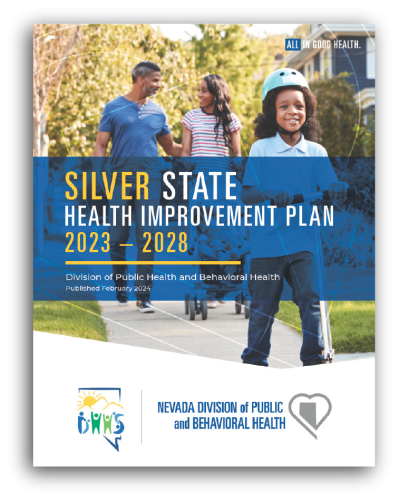Nevada's Health Improvement Plan: A Blueprint for Behavioral Health Providers

Nevada has just published its first statewide health improvement plan. The Silver State Health Improvement Plan (SSHIP) is a plan that was developed collaboratively by the Division of Public and Behavioral Health (DPBH) and community stakeholders. The plan is a 5-year plan that will outline critical priorities for the state for 2023-2028. The plan sets forth a comprehensive roadmap to enhance the well-being of all Nevadans.
Behavioral health providers are integral to several priorities and play a vital role in implementing SSHIP’s strategic priorities. The plan outlines in detail four overarching strategic priorities, each crucial to fostering health for Nevadans:
- Access to Health Care: The plan acknowledges Nevada’s longstanding challenges in accessing primary, oral, and behavioral health care services. Addressing workforce shortages and enhancing service provision is central to this priority.
- Mental Health and Substance Use: With a spotlight on children’s behavioral health, crisis response systems, and substance use prevention and treatment, SSHIP underscores the urgency of bolstering mental health services statewide.
- Social Determinants of Health: Recognizing the profound impact of social factors on well-being, SSHIP targets food security, health literacy, air quality/climate change, and supportive housing. Behavioral health providers, attuned to the interplay between social determinants and mental health outcomes, can collaborate to address these crucial factors that play a role in a person’s mental health.
- Public Health Infrastructure: The plan emphasizes the need for robust funding, workforce development, and technological modernization within Nevada’s public health system. Behavioral health providers are integral to this infrastructure, contributing expertise and insights to fortify the state’s health framework.
A pervasive concern within the fabric of Nevada’s health landscape lies a pressing problem: mental health. Statistics paint a stark picture, with one in five adults and youth grappling with mental illness annually. Despite these alarming figures, Nevada ranks 51st in the nation for mental health support, highlighting the urgent need for intervention. The ramifications extend beyond individual suffering to encompass societal impacts and economic burdens. Nevada’s SSHIP underscores the urgency of addressing critical behavioral health issues that affect individuals, families, and communities statewide. Let’s explore the essential mental health and substance use areas highlighted in SSHIP and the metrics identified to measure across the five-year plan.
Children’s Mental Health
The mental health crisis among young people in Nevada, exacerbated by the COVID-19 pandemic, has highlighted significant gaps in access to behavioral health services. Despite the critical need for early intervention, two-thirds of youth requiring mental health treatment do not have access to it, leading to long delays between symptom onset and treatment. This delay has detrimental effects on both children and their families, including school dropout, unemployment, and involvement in the criminal justice system. Particularly challenging is the lack of access for children with intellectual and developmental disabilities and those residing in rural areas.
Nevada faces various obstacles in providing adequate behavioral health services to children, as highlighted by a 2022 U.S. Department of Justice investigation. Insufficient access to community-based services often leads to unnecessary institutional placements, exacerbating adverse outcomes for children and families. Efforts are underway to address these challenges, including enhancing community-based services, expanding the Children’s System of Care, integrating social and emotional learning in schools, and establishing a Children’s Behavioral Health Authority.
To address these challenges effectively, Nevada aims to increase access to children’s behavioral health services by expanding home- and community-based services, developing a well-trained network of providers, reducing unnecessary institutional placements, and enhancing Medicaid benefits for children’s behavioral health services. These efforts reflect a comprehensive approach to improving access to care and support for children with mental health needs across the state.
Crisis Response
Crisis services are crucial within any behavioral health system, acting as the first point of contact for individuals undergoing mental health or substance use crises. Without timely access to these services, individuals often face detrimental outcomes, including involvement with the justice system, increased trauma, and death by suicide. Establishing a robust crisis response system is essential to effectively address behavioral health crises, reduce suicides, and guide individuals toward recovery and well-being, with particular attention to the unique needs of youth and families.
The 988 crisis call line provides individuals in crisis and their families access to trained counselors 24/7. This lifeline aims to divert non-medical suicide or mental health-related calls from the 911 system, providing a dedicated channel for behavioral health crises. In addition, mobile crisis response teams have been deployed to offer in-person support, while crisis stabilization centers serve as safe havens for individuals experiencing acute symptoms of mental illness.
Efforts to improve Nevada’s crisis response system are ongoing, with initiatives at both the state and local levels to enhance 988 call center operations, increase the availability of designated mobile crisis teams, and expand the number of crisis stabilization centers across the state. By aligning these efforts with national best practices and focusing on timely response and connection to services, Nevada aims to ensure that individuals and families in crisis receive the support they need, ultimately reducing the number of deaths by suicide and improving overall behavioral health outcomes.
Substance Use Prevention, Harm Reduction, Treatment, And Recovery
Efforts to improve substance use prevention, harm reduction, treatment, and recovery in Nevada are multifaceted and involve collaboration across various state, regional, and local sectors. Key initiatives include establishing the Statewide Substance Use Response Working Group (SURG) and the Advisory Committee for a Resilient Nevada (ACRN), created by legislative bills to review and guide efforts related to substance use disorders. Additionally, the Fund for a Resilient Nevada was established to allocate proceeds from opioid-related litigation towards statewide projects and grants aimed at addressing substance use disorders, with requirements for needs assessments and expenditure plans by regional entities.
A framework for coordinating and implementing evidence-based prevention programs and policies, such as Nevada’s Substance Abuse Prevention Plan, has been established. Federal grants, including the SUPPORT Act grants, aim to increase provider capacity for substance use disorder treatment and recovery services, with a focus on vulnerable populations such as adolescents, young adults, and pregnant women. Initiatives like the Overdose Data to Action program and the Opioid Antagonist Medication Saturation Plan target specific interventions to reduce overdose deaths and increase access to life-saving medications like naloxone.
Moving forward, objectives such as increasing public awareness, improving access to evidence-based treatment, strengthening early intervention strategies, supporting recovery-oriented systems of care, and fostering collaboration among stakeholders are outlined to guide efforts in addressing substance use issues effectively. These efforts are crucial in aligning with national objectives and ensuring that Nevadans have access to comprehensive substance use services in their communities, from prevention to recovery.
Investing in Mental Health and Substance Use Treatment and Prevention
Developing robust behavioral health systems requires significant and sustained investment, including workforce development, crisis response systems, children’s services, and substance use prevention and treatment. Currently, Nevada relies on a mix of state, local, and other funding sources to support initiatives to improve the behavioral health system. One crucial funding stream is the Community Mental Health Services Block Grant (MHBG), which covers a wide range of services for serious mental health conditions, uninsured individuals, community infrastructure, workforce improvement, and crisis response efforts. While these grants have driven progress, additional investments are necessary to meet the diverse needs of Nevadans.
According to the plan, new investments should not merely redistribute existing funds but instead identify and leverage new opportunities and funding sources. This includes maximizing Medicaid and federal funding, aligning funding with desired outcomes, and exploring private sector and philanthropic contributions. The 2023 Behavioral Health Community Integration Plan outlines recent efforts to increase funding and sustainability for behavioral health, highlighting remaining gaps and strategies to address them. Objectives under Goal 4 of the plan focus on increasing investment from various sources, such as raising reimbursement rates for behavioral health services, expanding non-medical wraparound services, enhancing financial incentives for behavioral health professionals, and encouraging the private sector and philanthropic support for comprehensive behavioral health services. Nevada can strengthen its behavioral health system by pursuing these objectives to serve its population better.
Access to Care
Access to services is essential for addressing mental health and substance use disorders, yet Nevada faces significant challenges in providing adequate care. The state ranks poorly in access to mental health care, with many residents lacking treatment despite meeting criteria for mental illness or substance use disorder. Particularly concerning is the lack of access for children, as previously described, which is exacerbated by insufficient community-based services and a shortage of behavioral health providers. This shortage, affecting both rural and urban areas, results in long wait times for assessments and services, leading to missed opportunities for early intervention, especially for children. The COVID-19 pandemic has further strained the behavioral health workforce, increasing demand for services while exacerbating workforce challenges such as burnout and job satisfaction.
Efforts to improve the behavioral health workforce in Nevada are underway, including initiatives to enhance the pipeline of providers, offer loan repayment incentives, and expand telehealth services. These efforts address workforce shortages, especially in underserved areas, and increase access to care for all Nevadans. Additionally, cultural competency training, the integration of community health workers and peer recovery support specialists, and professional development opportunities are being prioritized to enhance the quality and effectiveness of behavioral health services. Aligning with statewide goals and objectives, these initiatives seek to grow and diversify the behavioral health workforce, ultimately improving all residents’ access to mental health and substance use services.
To address these overarching mental health and substance use goals, the following metrics are being tracked to assess progress. DPBH will monitor these indicators through July 2028.
- Decrease the number of children and youth at out-of-state residential treatment centers.
- Decrease the total number of youth placements in residential treatment centers that are longer than 15 days.
- Increase the number of school districts that collect and report data regarding student referrals and access to school- and community-based behavioral health providers.
- Decrease the number of deaths by suicide.
- Decrease the number of suicide attempts.
- Decrease the portion of Medicaid super-utilizers with behavioral health challenges who seek care in hospital emergency departments.
- Improve specific 988 performance metrics.
- Decrease unintentional drug deaths statewide.
- Increase percent of Medicaid budget dedicated to behavioral health services.
- Increase the number of school districts billing Medicaid for behavioral health services.
- Decrease the number and percentage of the state population living in a mental health professional shortage area.
- Increase the number of behavioral health professionals working in K-12 schools.
- Increase the number of school districts collecting data regarding student referrals and access to school- and community-based behavioral health providers.
- Increase the number of behavioral health professionals who receive loan repayment from a state loan repayment program.
While SSHIP’s publication marks a significant milestone, its impact lies in implementation. Behavioral health providers are urged to align their efforts with SSHIP’s goals, utilizing the plan to guide their practice and advocacy initiatives. By embracing SSHIP’s priorities and leveraging their expertise, providers can catalyze meaningful change in mental health services, substance use prevention, and broader health equity initiatives. Collaboration across sectors is vital, as SSHIP calls for a collective approach to improving health outcomes statewide.
As we navigate the complexities of behavioral health, collaboration emerges as our most potent weapon. From frontline providers to policymakers, each stakeholder plays a pivotal role in shaping Nevada’s behavioral health landscape. As we navigate the road ahead, we can build a healthier, more resilient Nevada for all its residents.
We encourage you to review the full plan here. If you have any questions about the plan, you are encouraged to reach out to mcomlossy@unr.edu.
Blog Post Tags:
Related Blog Posts
Related Learning Labs
Related Resources
.
- Buscar Tratamiento de Calidad para Trastornos de uso de Sustancia (Finding Quality Treatment for Substance Use Disorders Spanish Version)
- Finding Quality Treatment for Substance Use Disorders
- Focus On Prevention: Strategies and Programs to Prevent Substance Use
- Monthly Variation in Substance Use Initiation Among Full-Time College Students
- The National Survey on Drug Use and Health (NSDUH) Report: Monthly Variation in Substance Use Initiation Among Adolescents







